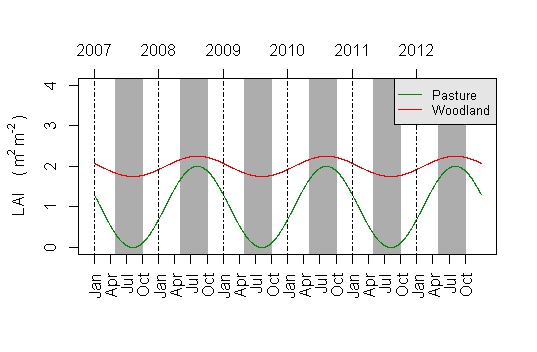博文
USE R 画出LAI的时间变化
|||

这幅图是2007年到2012年的LAI的多年变化,假设我们想对比两个站点的LAI, 这里用的是SIN 函数模拟的数据,你可以换成自己的数据,温度的或者其他的都可以。希望对您有帮助!
在R中,用以下代码,可以画出来。
# first construct the plot function
# timeP is to store time lables
fly_plot <- function(timeP, dataP1, dataP2, ylimup, ylabs,typeP='l')
{
plot(timeP, dataP1, type=typeP, xaxt = "n", col='green4',cex=0.5,
ylim=c(0,ylimup), xlab="",ylab='')
polygon(c(strptime('2007/5/1',"%Y/%m/%d"), strptime('2007/10/1',"%Y/%m/%d"),strptime('2007/10/1',"%Y/%m/%d"),strptime('2007/5/1',"%Y/%m/%d") ), c(-0.036*ylimup, -0.036*ylimup, ylimup+0.036*ylimup, ylimup+0.036*ylimup),col='grey68',border='grey68')
polygon(c(strptime('2008/5/1',"%Y/%m/%d"), strptime('2008/10/1',"%Y/%m/%d"),strptime('2008/10/1',"%Y/%m/%d"),strptime('2008/5/1',"%Y/%m/%d") ), c(-0.036*ylimup, -0.036*ylimup, ylimup+0.036*ylimup, ylimup+0.036*ylimup),col='grey68',border='grey68')
polygon(c(strptime('2009/5/1',"%Y/%m/%d"), strptime('2009/10/1',"%Y/%m/%d"),strptime('2009/10/1',"%Y/%m/%d"),strptime('2009/5/1',"%Y/%m/%d") ), c(-0.036*ylimup, -0.036*ylimup, ylimup+0.036*ylimup, ylimup+0.036*ylimup),col='grey68',border='grey68')
polygon(c(strptime('2010/5/1',"%Y/%m/%d"), strptime('2010/10/1',"%Y/%m/%d"),strptime('2010/10/1',"%Y/%m/%d"),strptime('2010/5/1',"%Y/%m/%d") ), c(-0.036*ylimup, -0.036*ylimup, ylimup+0.036*ylimup, ylimup+0.036*ylimup),col='grey68',border='grey68')
polygon(c(strptime('2011/5/1',"%Y/%m/%d"), strptime('2011/10/1',"%Y/%m/%d"),strptime('2011/10/1',"%Y/%m/%d"),strptime('2011/5/1',"%Y/%m/%d") ), c(-0.036*ylimup, -0.036*ylimup, ylimup+0.036*ylimup, ylimup+0.036*ylimup),col='grey68',border='grey68')
polygon(c(strptime('2012/5/1',"%Y/%m/%d"), strptime('2012/10/1',"%Y/%m/%d"),strptime('2012/10/1',"%Y/%m/%d"),strptime('2012/5/1',"%Y/%m/%d") ), c(-0.036*ylimup, -0.036*ylimup, ylimup+0.036*ylimup, ylimup+0.036*ylimup),col='grey68',border='grey68')
lines(timeP, dataP1, type=typeP, xaxt = "n", col='green4',cex=0.5,
ylim=c(0,ylimup), xlab="",ylab='')
lines(timeP, dataP2, type=typeP, xaxt = "n", col='red2',cex=0.5,
ylim=c(0,ylimup), xlab="",ylab='')
axis.POSIXct(1, at = seq(r[1], r[2], by = "3 months"), format = "%b",las=2)
#axis.POSIXct(1, at = seq(r[1], r[2], by = "2 months"), labels=NA)
axis.POSIXct(3, at = seq(r[1], r[2], by = "1 years"), format="%Y")
axis.POSIXct(1, at = seq(r[1], r[2], by = "1 years"), labels=NA, lty=4, tck=1)
mtext(side=2, ylabs,line=2.5)
}
# plot LAI time series ----
# The LAI data is constructed by myself, and you can replace it with your data.
x = seq(0.9,6.9,by=1/365)
dataP1 = sin(pi*x)+1
dataP2 = 0.25*sin(pi*x)+2
timeP = seq(strptime('2007/1/1',"%Y/%m/%d"), by = "1 days", length.out = length(dataP1))
r <- as.POSIXct(round(range(timeP), "days"))
Sys.setlocale("LC_TIME", "US")
ylimup = 4
ylabs = expression(paste('LAI ( m'^'2 ','m'^'-2 ',')'))
fly_plot(timeP, dataP1, dataP2, ylimup, ylabs,typeP='l')
legend('topright', 1.04*ylimup, c("Pasture", "Woodland"),
col = c('green4','red2'), cex=0.8, lty = c(1,1),merge = TRUE, bg = "gray90")
# 保存成tiff格式,分辨率设为300
tiff('LAI_fly.tiff',width=8,height=3.5,pointsize = 12,units='in',res=300)
LAI_fly = fly_plot(timeP, dataP1, dataP2, ylimup, ylabs,typeP='l')
legend("bottomright",c("Pasture", "Woodland"),
col = c('green4','red2'), cex=0.8, lty = c(1,1),merge = TRUE, bg = "gray90")
dev.off()
https://blog.sciencenet.cn/blog-526092-796059.html
上一篇:R 读取通量数据中的时间ID格式处理
下一篇:有关生理生态、农林气象、小气候、环境物理的网站和资料